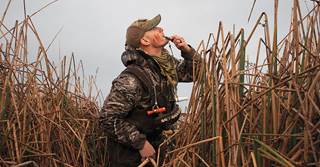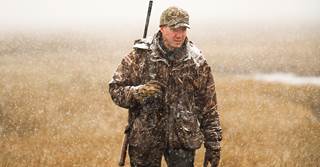Calling Accents
Hunters in some of the country's most celebrated waterfowling regions have developed their own unique ways of speaking a duck's language
Hunters in some of the country's most celebrated waterfowling regions have developed their own unique ways of speaking a duck's language

By Hampton Bourne
I'm from the South. I've lived here all my life. My wife is from the North. She is still assimilating to this part of the country, but there's much that she enjoys about our regional culture. And although she continues to insist that I'm the one with the accent, she's beginning to sound more southern all the time. I've even noticed the occasional "y'all" slipping into her daily parlance. At first it sounded awkward. Now I find it almost elegant.
We can often recognize where people come from by the way they speak. And if you have been fortunate enough to hunt in various parts of the country, you might have noticed differences in the ways that waterfowlers speak to ducks. Regionality can have a strong influence on calling styles. You could even say that duck callers from different regions have their own calling accents. Hunters who wade in the Arkansas timber have a different way of speaking a duck's language than those who hunt the salt marshes of the East Coast, for example. These differences are born from years of experience hunting in unique environments and from the rich and varied waterfowling traditions from California to Maine.
Following is an overview of five of the nation's most distinctive regional calling styles from some of the people who know them best.

Photo © Austin Ross
Geographically small in comparison to other historic waterfowling areas, the greater Reelfoot Lake area of northwest Tennessee has probably had more impact on duck calling than any other region. Formed by a series of massive earthquakes in the early 1800s, this unique lake is a winter haven for ducks and geese and is known as the home of the highball call.
The development of modern duck calls can be traced to a narrow region stretching from southern Illinois to west Tennessee with Reelfoot as its epicenter. Famous call makers like Victor Glodo and Johnny Marsh were pioneers in the duck call industry, and in the early to mid-20th century they developed big-barreled metal reed calls that helped give them an edge over the competition. Those very loud, high-pitched calls became the chosen tools for traditional Reelfoot callers.
"The Reelfoot calling style is different because it's a combination of highballs," says game-call historian, author, and collector Howard Harlan. "This call doesn't actually sound like a duck, but it works. We'll use this technique to call to high ducks, but we'll also use it to call a duck right to the blind. Some people do use plastic-reed calls, but the metal reeds ring like a tuning fork.
"I have always believed that a high-pitched call has to be sharp and not flat," Harlan continues. "Whoever is hitting a note the sharpest will end up with more ducks, especially on days with a lot of wind. When there's a section of the lake with a multitude of blinds all working together and making that ringing highball, it's mesmerizing to passing waterfowl. It's a large footprint making a tremendous sound.
"Calling in the early season is often different than calling in the late season, though," he explains. "Earlier you see a lot of younger ducks that are more susceptible to good calling. Because of that, they're usually the first ones harvested. Later in the season you have to work a lot harder to get the ducks to come down to you because they've heard calling all the way down the flyway."

Photo © Ed Wall Media
If the Reelfoot style is a hammer, the Louisiana style is a scalpel. Rod Haydel, president of Haydel's Game Calls, and his family have been making duck calls and hunting the bayous for decades. "Louisiana is unique because we historically winter more ducks than anywhere else in the United States," Haydel says. "Because of that, we rarely call at high, migrating ducks. Most calling in Louisiana is more subtle with a lot of finesse and a lot of single, spaced-out quacks. On flight days, hail calls will work, but we don't normally see the masses of migrating birds that other areas of the flyway see, and they don't require heavy calling to get a response.
"Very commonly birds will get up early in the morning to fly offshore and sit on the water in the Gulf of Mexico," he says. "Around midday those ducks will come back into the marshes to feed. If you're in the marsh when they come back, you just need to guide them to your decoys, rather than breaking them off of a migration pattern."
Haydel and other Louisiana hunters also like to add some extra Cajun flair to their repertoires. "In the old days hunters would make basic handmade duck calls from cane," Haydel explains. "When they blew a lot of air through those old calls, they would often get a squeaking sound at the end of a note. That's how the Cajun squeal was born. The old-timers liked it, because they thought that ducks made that sound when they had a lot of grain in their throats. And today that sound has become synonymous with the Louisiana style of calling.
"Even though it's a popular sound to make in Louisiana, I've successfully used the Cajun squeal all over North America," Haydel says. "When I'm making a single quack, midway through the note I switch from blowing hot air from my diaphragm to blowing cold air through my lips. The best way to do this is by pinching your lips down over the opening in the middle of the note. It almost looks like you're chewing on the end of the call. The change in air temperature makes the reed change its vibration and produces this unique sound. It really works."

Photo © James Leash/sharpeyeimages.com
Mickey Saso didn't invent the pintail whistle, but he undoubtedly put it on the map. The founder of Wingsetter Calls, Saso was inducted into the California Waterfowlers Hall of Fame in 2019 and is widely recognized as one of the nation's foremost experts on the art of calling whistling ducks.
"The Central Valley of California is a whistling-duck haven," Saso says. "The sheet water in the rice fields of Northern California and the Grasslands of central California creates perfect habitat for pintails and wigeon. These two species fly together and sit on the water together and will even migrate from Canada to Mexico together."
Saso prefers to combine different styles when calling these mixed flocks. "Always use a whistle alongside a mallard call," he says. "Start with a hail call when ducks are far off. As they come your direction, start mixing in single hen quacks and feeding chuckles with whistles. Once they're committed and circling, put down the mallard call and only use the whistle. Most hunters over-call and spook pintails with mallard calls when the birds are close.
"To make that pintail sound with a whistle, flutter your tongue in two-note sequences. Imagine saying tweet tweet in a normal voice with normal cadence. That's the speed. Wigeon calls are a quick three-note laugh without any flutter. They're a little higher-pitched than pintail calls, with emphasis on the second note: hee-HEE-hee. Even if there aren't wigeon in the flock you're calling to, mix in some wigeon whistles with pintail whistles. A whistle isn't an attractor call. It's a finishing call, and wigeon calls are confidence calls for pintails. If you talk to a true sprig hunter, they'll tell you that pintails are tough to fool but by far the best ducks to hunt."

Photo © billbuckleyphotography.com
In contrast to the hustle and bustle of the metropolitan Northeast, calling ducks in the sprawling salt marshes of coastal New England is an understated affair. Hank Garvey has hunted up and down the Atlantic coastline for almost 50 years, and the Newburyport, Massachusetts, resident has learned a thing or two about pulling ducks in close.
"The East Coast-and the Northeast in particular-is famous for its black duck hunting," Garvey says.
"Black ducks are extremely wary. You don't hear them making a lot of noise. When they're in flight, you'll hear a short, sweet quack, but they won't necessarily chatter back and forth. A mallard hen on the water will make a lot of noise when she's calling to passing ducks, but black ducks don't do that. Instead, they make low, longer, more drawn-out quacks.
"I prefer a quieter call with a single reed and a clean tone," Garvey continues. "I have used double-reed calls in the past, but I prefer a single-reed call because of its flexibility. I also stay away from raspy, nasally sounding calls. Black ducks don't really make those types of sounds.
"Our goal is to be able to call softly, and our main hunting strategy involves a lot of pre-hunt scouting," Garvey explains. "We hope to find out where the ducks are going so we don't have to try to attract them from a long way off with calls that are unnatural to them. You can tell the guys who haven't hunted here a lot because they'll use a lot of decoys and a lot of hail calls. If a bird is working and starts to turn away, I'll give it a very abbreviated hail call, but nothing like if I were hunting mallards in the Midwest. I use a little more emphasis to try to turn them, but they're so wary that if you get on them too hard, they'll never come back."

Photo © Blake Fisher/rntcalls.com
If there's an epicenter of the duck universe, it's probably Stuttgart, Arkansas. And if anyone knows about the Arkansas style of calling, it's John Stephens. President of Stuttgart-based Rich-N-Tone Calls and a three-time world duck calling champion, Stephens can "speak duck" with the best in the world.
"One thing about duck calling in Arkansas is that it is just a part of who we are," he says. "There are so many call makers in this area, and the World's Championship Duck Calling Contest is held here every year. Kids in this area start learning how to blow a call at a very early age. We consider calling the most important part of duck hunting, even more so than your decoy spread. We really consider it an art form.
"The Arkansas style of calling is one that's very vocal," Stephens continues. "Here we have great public hunting and have held so many ducks over the years that it creates a lot of competition from other hunters and from live ducks on the water. When mallards group together on the water in the timber, the sound reflects off the water and all the trees and sounds like a roar. Ducks lock in on that sound, and it's very difficult to pull any ducks away from the live ducks without fighting fire with fire.
"A raspy sound with a lot of volume and a lot of bass is synonymous with the Arkansas style," Stephens says. "If nothing else, callers should just make a lot of racket-ideally with multiple callers. When you're on the water, that sound seems to carry better and combat the roar that the masses of real ducks are making. As ducks get closer, we shift gears and start making more realistic sounds. I'm sure there are times when we call more than we should, but it all started from hunting in timber and having to compete with so many people and so many birds."
Ducks Unlimited uses cookies to enhance your browsing experience, optimize site functionality, analyze traffic, and deliver personalized advertising through third parties. By continuing to use this site, you agree to our use of cookies. View Privacy Policy